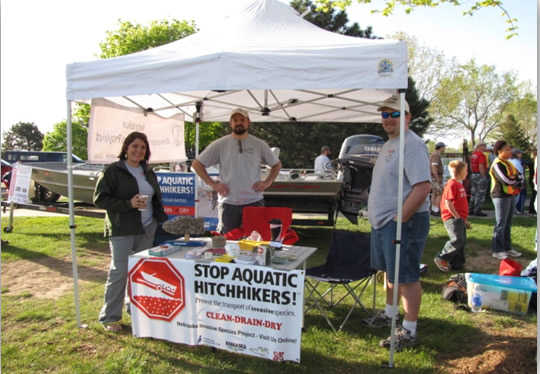
By Karie Decker, coordinator of the Nebraska Invasive Species Project
The United States is spending more than $120 billion dollars annually dealing with problems caused by the estimated 50,000 plant, animal, and microbe invasive species that aren't kept in check by natural predators. In Nebraska, invasive species are one of the most commonly identified threats to our natural legacy. The Nebraska Invasive Species Project brings together more than a dozen agencies and organizations to help thwart the effects of invasive species and to help prevent new arrivals. Funded by a federal aid grant from the Nebraska Game and Parks Commission and additional grants from the U.S. Fish and Wildlife Service and the Nebraska Environmental Trust, the Nebraska Invasive Species Project coordinates research, develops management plans and disseminates information to provide an integrated management approach that is relatively seamless across institutional boundaries.
The zebra mussel scare in Nebraska
In Nebraska, we rely on our limited water sources for a number of activities such as agriculture, recreation, and drinking water. Invasive species threaten the quality and availability of water. In the summer of 2010, Nebraska was seemingly free and clear of zebra mussels, but in the fall of 2010, Nebraskans were hit with devastating news … twice. In September 2010, officials at Offutt Air Force Base Lake announced an earlier treatment to eradicate zebra mussels had failed; adult zebra mussels had been found. Then in November 2010, the Nebraska Invasive Species Project received a report from a Boy Scout of a zebra mussel in Omaha's Zorinsky Lake. Based on previous research in other states, Zorinsky Lake was drawn down approximately 20 feet to freeze and dry out the invasive species during the winter.
Fast forward
In April 2011, the Nebraska Invasive Species Project was awarded a grant from the Nebraska Environmental Trust to develop an Aquatic Invasive Species Prevention Program, and received additional funding from Nebraska Game and Parks Commission to beef up zebra mussel sampling. In 2011, technicians hired by the UNL Invasive Species Project, which is part of the Nebraska Cooperative Fish & Wildlife Research Unit, sampled more than 40 reservoirs around the state for zebra mussel veligers (larvae). Luckily, all samples from 2011 were negative for zebra or quagga mussels. As for Zorinsky Lake – things are looking up. The lake is refilling and fish were stocked last fall. We anticipate a full recovery. Celebrate the re-opening of Zorinsky Lake with us this April. Look for event details on the Nebraska Invasive Species Facebook page.
Also in 2011, temporary staff hired through the Nebraska Invasive Species Project conducted boater surveys designed to gauge public knowledge of invasive species, to track where boaters are coming from and going to, and to teach boaters how to prevent the spread of aquatic invasive species. Our staff surveyed more than 3,100 boaters from 18 different locations around the state. Results suggest that in western Nebraska, nearly 60 percent of those surveyed had previously heard of zebra mussels, compared to 86 percent and 77 percent in central and eastern Nebraska, respectively. However, only 34 percent of boaters state-wide seem to take the time to inspect their boats for aquatic invasive species, suggesting a need to improve our education efforts for the 2012 season. In addition, it appears that at Lake McConaughy, nearly 50 percent of the boaters are from out of state -- primarily Colorado, but also Iowa, Kansas, Wyoming, and other states -- compared to 16 percent in central and eastern Nebraska.
During surveys, technicians also taught prevention techniques to the public. More than 15,000 individuals were trained with Nebraska’s Clean, Drain, and Dry Protocol. Setting up voluntary watercraft inspection and decontamination stations can also help prevent the spread of aquatic invasive species by intercepting high-risk boats and by educating the public during the inspection process. In 2011, technicians at inspection stations completed more than 350 voluntary watercraft inspections and intercepted two high-risk boats that were subsequently decontaminated before launching into Nebraska waters.
Legislation
A bill advanced this month in the Nebraska Legislature that would help Nebraska’s agencies better manage invasive species in the future. LB391 creates the Nebraska Invasive Species Advisory Council and an amendment under this bill, AM1928 (formerly LB392) prohibits the transport and introduction of aquatic invasive species in Nebraska and gives the Nebraska Game and Parks Commission the authority to further develop rules and regulations in the future.
An ounce of prevention is worth a pound of cure
As we approach the spring, we are optimistic about the endeavors of the Nebraska Invasive Species Project: the Zorinsky Lake treatment, intensive zebra mussel sampling, our tremendous outreach efforts and surveys and so much more. We are processing all of the data from our summer and fall surveys to better direct our efforts in 2012.
Boaters and anglers, you can plan on seeing us out there again in 2012. We hope to provide all the information we can about inspecting boats for invasive species. Preliminary analysis of surveys indicates that Lake McConaughy, Harlan County Reservoir, and various reservoirs in Eastern Nebraska are still at high risk for invasive species introductions, particularly zebra mussels. Zorinsky Lake and Offutt Base Lake served as great warnings; given the opportunity, we would really like to increase prevention efforts across the state. In addition, we plan to expand our program to include people affected by other invasive species, such as waterfowl hunters whose activities are affected by the common reed. We would like to follow the campaigns led by neighboring states that empower boaters, hunters and anglers alike in the fight against invasives.
More details at: http://go.unl.edu/yox